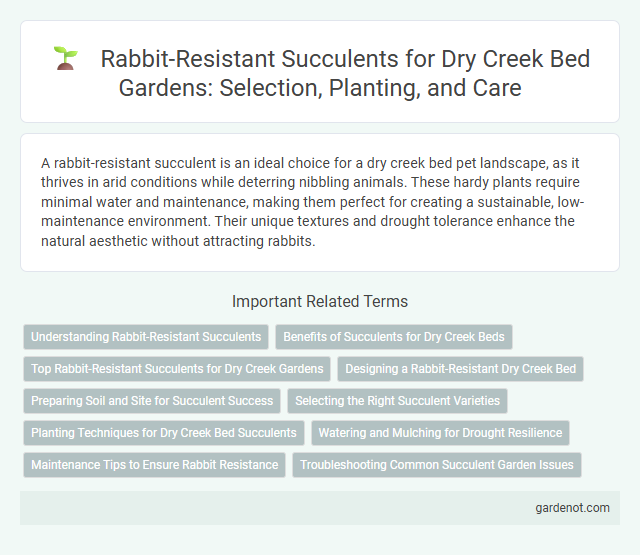A rabbit-resistant succulent is an ideal choice for a dry creek bed pet landscape, as it thrives in arid conditions while deterring nibbling animals. These hardy plants require minimal water and maintenance, making them perfect for creating a sustainable, low-maintenance environment. Their unique textures and drought tolerance enhance the natural aesthetic without attracting rabbits.
Understanding Rabbit-Resistant Succulents
Rabbit-resistant succulents such as Sedum, Agave, and Euphorbia thrive in dry creek bed landscapes due to their tough, fibrous leaves and bitter sap, which deter rabbits from feeding. These plants require minimal water and adapt well to the rocky, well-drained soil commonly found in arid environments, enhancing garden resilience. Selecting rabbit-resistant succulents reduces the need for chemical repellents and supports sustainable xeriscaping practices.
Benefits of Succulents for Dry Creek Beds
Succulents, especially rabbit-resistant varieties like Sedum and Agave, thrive in dry creek beds due to their drought tolerance and low water requirements. Their thick, fleshy leaves store moisture, reducing irrigation needs and preventing soil erosion on slopes. These resilient plants also enhance the aesthetic appeal while minimizing damage from common garden pests like rabbits.
Top Rabbit-Resistant Succulents for Dry Creek Gardens
Hens and chicks (Sempervivum) thrive in dry creek beds due to their rosette shapes and dense leaf clusters, which deter rabbits effectively. Sedum varieties, especially Sedum album and Sedum spurium, offer drought tolerance and a rabbit-resistant trait, making them ideal for rocky, well-drained conditions. Agave species add structural interest with their spiky leaves while naturally repelling rabbit browsing in dry, arid garden settings.
Designing a Rabbit-Resistant Dry Creek Bed
Designing a rabbit-resistant dry creek bed involves selecting hardy, drought-tolerant succulents like Agave, Sedum, and Sempervivum, which rabbits typically avoid due to their tough, fibrous leaves and bitter taste. Incorporating these succulents with coarse gravel and larger rocks creates a textured environment that discourages rabbit activity while enhancing drainage. Strategic planting in raised beds or mounded areas further reduces rabbit access, ensuring a resilient, low-maintenance dry creek bed.
Preparing Soil and Site for Succulent Success
Preparing soil for rabbit-resistant succulents in a dry creek bed involves ensuring excellent drainage by incorporating coarse sand or gravel to prevent water retention that can attract pests. Selecting a sunny, well-drained site with minimal organic matter helps discourage rabbit activity while promoting healthy succulent growth. Using raised beds or mounded soil can further protect succulents from moisture-related issues and increase their resilience in arid environments.
Selecting the Right Succulent Varieties
Selecting rabbit-resistant succulent varieties such as Agave, Aloe, and Euphorbia is essential for thriving dry creek beds. These succulents possess tough, spiky textures and bitter sap which deter rabbits. Incorporating drought-tolerant species like Sedum and Sempervivum also ensures low-maintenance landscapes resistant to rabbit damage.
Planting Techniques for Dry Creek Bed Succulents
Plant drought-tolerant, rabbit-resistant succulents like Agave, Sedum, and Sempervivum in well-draining soil within a dry creek bed to prevent root rot and withstand arid conditions. Incorporate coarse sand and gravel at the base for enhanced drainage, and position plants with adequate spacing to optimize airflow and reduce moisture retention. Use natural fencing or planting dense groundcovers such as lavender to deter rabbits while maintaining the creek bed's aesthetic and ecological balance.
Watering and Mulching for Drought Resilience
Rabbit-resistant succulents thrive in dry creek beds due to their low water requirements and drought resilience. Watering should be infrequent but deep, promoting strong root development while preventing rot, ideally allowing the soil to dry out completely between sessions. Applying a layer of mulch helps retain soil moisture, suppresses weeds, and maintains a stable temperature, enhancing the succulent's survival in arid conditions.
Maintenance Tips to Ensure Rabbit Resistance
Choosing rabbit-resistant succulents like Sedum, Echeveria, or Agave is crucial for a dry creek bed to thrive without frequent damage. Regularly inspect plants for signs of nibbling and maintain well-drained soil to discourage rabbits, as they avoid dry, rough textures. Applying natural repellents and keeping surrounding areas clean of debris also enhances protection and supports plant resilience.
Troubleshooting Common Succulent Garden Issues
Rabbit-resistant succulents such as Euphorbia rigida and Agave species help reduce plant damage in Dry Creek Bed gardens, minimizing frequent replanting needs. Troubleshooting common succulent garden issues involves identifying water drainage problems, as succulents require well-drained soil to prevent root rot and fungal infections. Monitoring for pests like aphids or mealybugs and maintaining proper sun exposure optimize succulent health and longevity in arid, rocky landscapes.
Rabbit-resistant succulent Infographic

 gardenot.com
gardenot.com